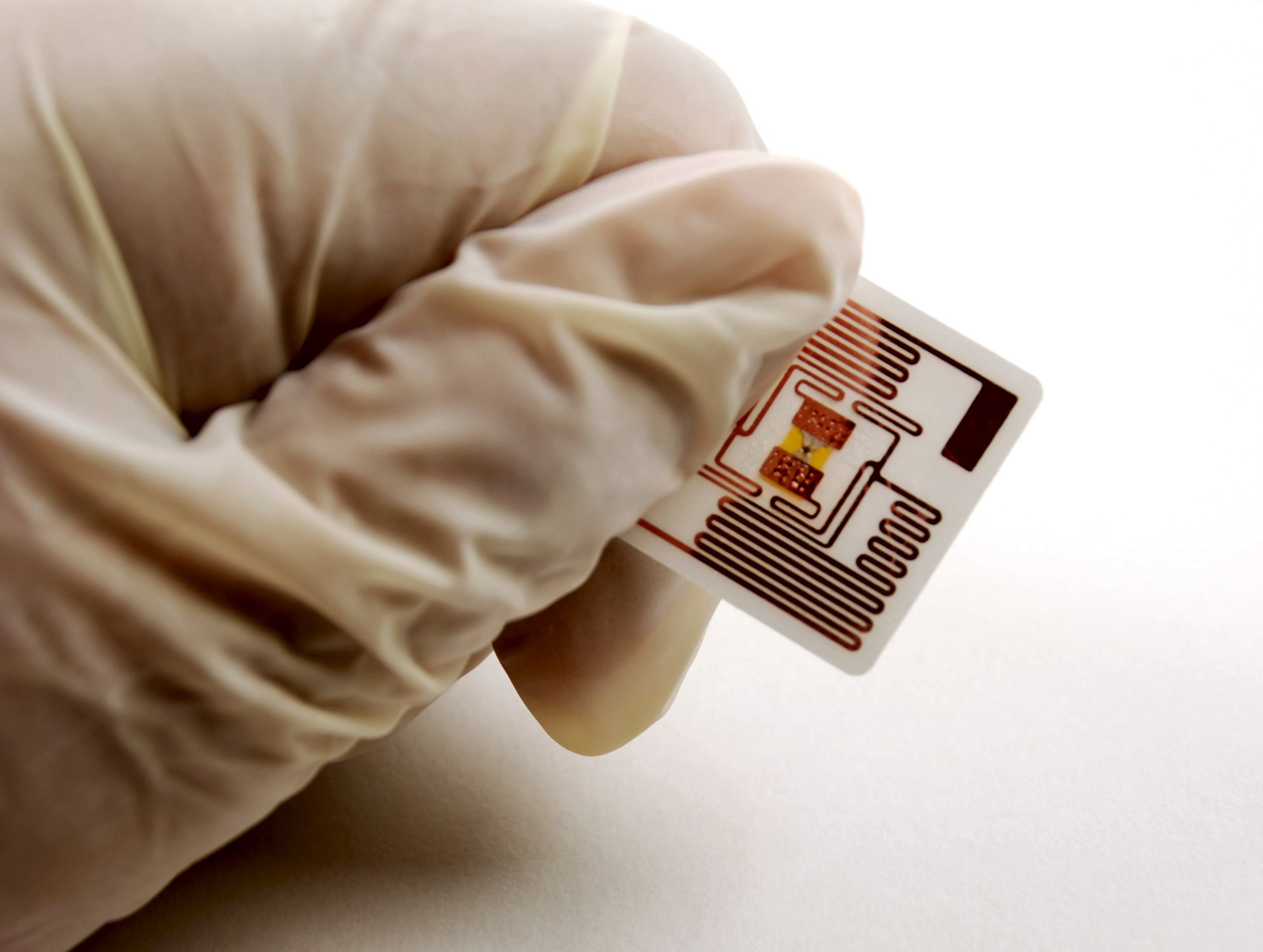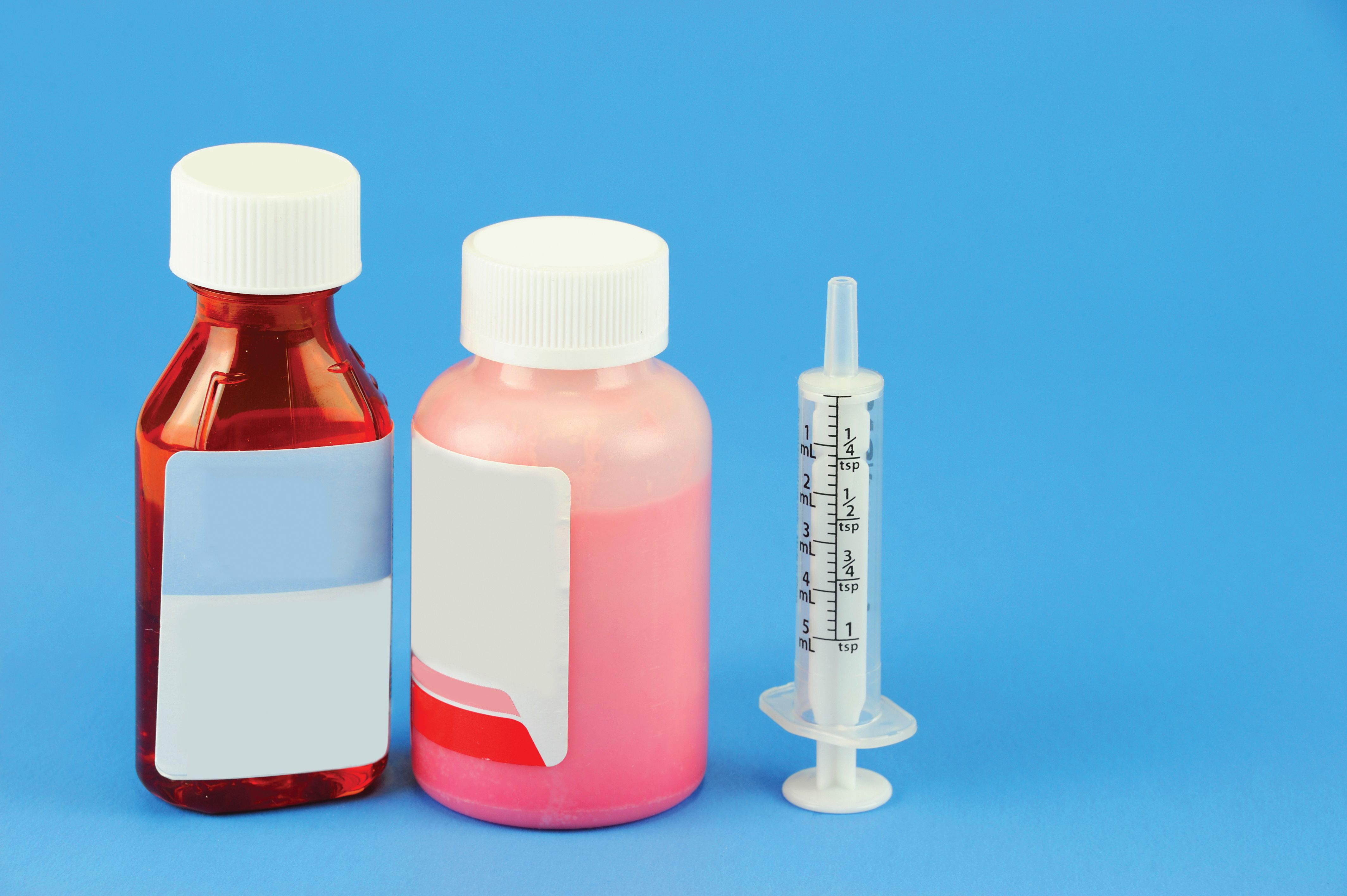Publication
Article
Pharmaceutical Technology
The Effect of Carrier Material on the Measured Resistance of Spores
A biological indicator (BI) measures the effectiveness of the sterilization process to which it is subjected. Factors such as the test organism, the packaging, the culture material, and the test system all influence a BI's resistance. Carrier material is an often-overlooked factor that also influences BI resistance. The authors examine various solid and liquid carriers, describe their properties, and investigate how they influence BI resistance.
A biological indicator (BI) is an "inoculated carrier contained within its primary pack ready for use and producing a defined resistance to the specified sterilization process"(1). The biological component of the BI typically is bacterial endospores.
Defined resistance is a quantitative measure generally expressed in units of time or dose. This value can be the point of BI inactivation (kill). More commonly, resistance is expressed as a D-value. D-value is defined as the time or radiation dose required to inactivate 90% of a population of the test microorganism under stated exposure conditions (1).
Many factors influence the measured resistance of a BI, including the test organism, the carrier material, the primary packaging, the culture medium used for the recovery of stressed spores, and the test system (2–6). The carrier material and packaging often are overlooked as influences on a BI's resistance. All of these items must be controlled to achieve predictable and consistent BI performance.
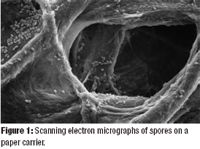
Figure 1
A major misunderstanding in the industry is that spores have an intrinsic D-value. This assertion is not true if for no other reason than it is impossible to test the resistance of individual spores suspended in space. For testing purposes, the spores are placed onto a surface or suspended in a liquid, and this system becomes the BI. It is the resistance of the system that is measured, not simply the spores. The bacterial spores integrate all known and unknown critical process variables. This article focuses on the effect of carrier materials on the measured resistance of spores on solid and in liquid carrier materials.
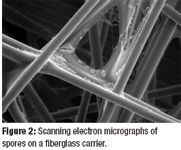
Figure 2
A myriad of solid and liquid carrier materials can be used. Solid carriers can be fibrous (e.g., paper, woven polymers, and fiberglass material) or nonfibrous (e.g., stainless steel, plastic, and rubber). Liquid carriers include water, oil, nutrient medium, and pharmaceutical products.
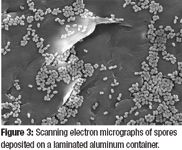
Figure 3
Commercially prepared spore suspensions are used as components in the BI-manufacturing process. Spore suspensions typically are labeled with a D-value. This D-value usually is collected on a carrier of convenience and should be stated on the certificate of analysis (C of A). The spore suspension by itself, however, is not the BI system that the user employs. These suspensions inoculate carriers that then become the BI system. The D-value of the resulting BI system is not specified on the C of A. The C of A, however, provides the user with a means of comparison with previous spore lots.
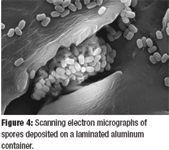
Figure 4
Inoculation of solid carriers
It is well understood that not all surfaces are equal. Spores interact differently with a surface depending on many factors, including surface topography, surface hydrophobicity, and spore-suspension diluent.
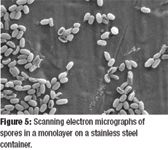
Figure 5
Spores are inoculated onto solid carriers by dispensing a specified volume of a calibrated spore suspension onto the carrier. If the carrier is fibrous, the spores will be wicked throughout the depth of the carrier. Figures 1 and 2 display spore placement on two different fibrous carriers.
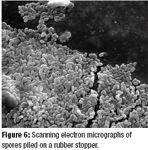
Figure 6
If the carrier is a nonfibrous solid, the spores will be deposited on a single plane of the carrier. Spores placed onto surfaces that are not perfectly smooth may settle in locations that prove difficult to sterilize, as demonstrated in Figures 3 and 4. Additionally, the surface quality of a carrier can affect BI resistance. Sigworth and Stark demonstrated that anodized aluminum with good surface quality resulted in much lower D-values (H2O2 sterilization) than other aluminum carriers (2). Several nonaluminum carriers with rough surfaces resulted in "acceptable" D-values, while other carriers with smooth surfaces showed increased resistance. These tests emphasized that a combination of carrier properties influence BI resistance, not a single carrier property.
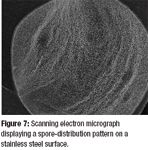
Figure 7
The spores can be distributed on the carrier in many forms, ranging from a well-dispersed monolayer to large aggregates, as demonstrated in Figures 5 and 6, respectively. Spore aggregates can be problematic depending on the sterilization process. The protection of spores in the center of these aggregates can lead to a perceived increased resistance and erratic results (tailing), which are experimental artifacts. Aggregates can be minimized by understanding the surface characteristics of the carrier and selecting an appropriate carrier liquid and spore population.

Figure 8
Spore concentration is the number of spores per volume of diluent. When a spore suspension is inoculated onto a solid surface, the inoculum forms a small bead. Depending on the composition of the diluent and the carrier, the footprint (i.e., inoculated area) and spore uniformity (within the area) vary, as demonstrated in Figures 7 and 8. The diluents typically are water or ethanol but may be other liquids.
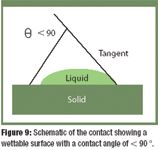
Figure 9
The wettablity of the surface by the selected carriers is measured by the critical-contact angle of the carrier (see Figure 9). The lower the critical-contact angle, the more wettable the surface. Wettable surfaces result in more uniform spore distribution on the carrier.
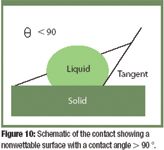
Figure 10
For example, water has greater surface tension than ethanol. The footprint of a water bead is smaller, but the height is greater. When they are on the same surface, water has a greater contact angle than ethanol. This property affects how suspended spores are deposited on the surface. Spore density increases when a defined number of spores are deposited over a smaller area. The drying time of the diluent also affects the spore distribution within the footprint. In general, a longer dry time results in a greater density of spores on the edge of the footprint. In the authors' experience, this "edge effect" (see Figure 10) is always present but is more pronounced with aqueous liquids with high surface tension (resulting in a longer drying time). The faster the liquid dries, the more homogenous the spore dispersion is.
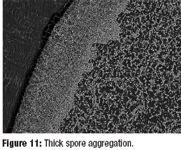
Figure 11
The edge effect may consist of only a densely packed monolayer of spores (see Figure 11) or it may result in multiple layers of densely packed spores (see Figure 12). The difference may influence BI resistance depending on the sterilization process. The survivor kinetics of spores exposed to low-pressure plasma by Hury et al. demonstrated that D-values vary when one decreases the surface density of spores (7). Hury suggested that the diffusion of the sterilant was limited by a "shield effect" of stacked spores.
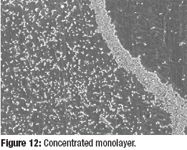
Figure 12
Sterilant interaction with carriers
Other factors that influence BI resistance include surface characteristics, surface topography, unit mass, heat capacity, and hydrophobicity of the carrier. The influence of these characteristics depends on sterilization processes.
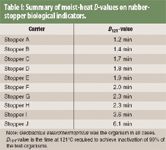
Table I: Summary of moist-heat D-values on rubber-stopper biological indicators.
Rubber stoppers respond differently to heat than glass or stainless steel. When stoppers are sterilized by moist heat, they heat very slowly and therefore may exhibit higher measured D-values. Rubber stoppers also may have surface coatings, which are another variable. Resistance testing performed on rubber stoppers demonstrated the range of D-values displayed in Tables I and II.
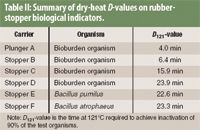
Table II: Summary of dry-heat D-values on rubber-stopper biological indicators.
Liquid carriers
Liquid-carrier BIs generally consist of hermetically sealed glass ampuls filled with the inoculated liquid, which usually is a culture medium. The physical and chemical properties of the liquid influence spore resistance. Properties such as pH, ionic strength, the concentration of active ingredients, and the viscosity of these liquids can cause spores to clump. Spore clumping may lead to erratic results and higher resistance. The effect of pH is demonstrated by phase-contrast microscopy in Figures 13–15. Changes in the pH of some liqu-ids may cause spores to form aggregates. As the pH shifts from neutral to acidic, the spores may form larger aggregates. The size of the aggregates can protect spores in the center of these clusters, which results in a higher observed resistance. This resistance cannot be considered an artifact of experimental error because the chemistry of the liquid has a similar effect on the bioburden that naturally occurs in the product.

Figure 13
A survivor-curve test performed on clumped spores in a pharmaceutical product resulted in a rapid drop in population during the initial phase (i.e., the death of single spores or small clumps), followed by tailing because of the presence of large clumps of spores. (see Figure 16). Data such as these initially may seem troublesome, but they are critical when developing a product-sterilization cycle.
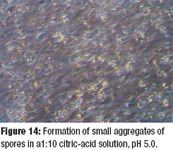
Figure 14
Liquid pharmaceutical product inoculated with spores used in BIs
The liquid spore carrier of a BI can be the pharmaceutical product itself. The excipients and active ingredients both can affect resistance. D-value studies performed on aqueous-based pharmaceutical products demonstrate that, in most cases, concentrations of active ingredients have little influence on the D-value. These results indicate that the excipients have the greatest impact on BI resistance. Test units using the same spores suspended in water for injection were prepared as a comparison (see Table III).

Figure 15
In the light of new and emerging materials and sterilization technologies, it is important to understand that spores are the only tool that can measure the lethality of a sterilization process effectively. Spores account for the substrate effect and the critical process parameters of the sterilization process itself.

Figure 16
Commercially available BIs designed to monitor sterilization processes should be correlated to the spore-resistance characteristics of the products that they monitor. This correlation will ensure the most appropriate challenge to the sterilization process. Ideally, the spore carrier of the BI should be composed of materials similar to those processed in the sterilizer. If this situation is not feasible, D-value studies can be performed on component materials in the load to determine the substrate effect of the load. Once the substrate effect is known, an appropriate BI can be selected and correlated to the process.

Table III: Summary of D-value study results on biological indicators using liquid pharmaceutical products and water for injection (WFI) as the spore carrier.
Kurt McCauley is the research and development laboratory manager and John R. Gillis, PhD,* is the president and CEO of SGM Biotech, 10 Evergreen Dr., Suite E, Bozeman, MT 59715, tel. 406.585.9535, fax 406.585.9219, info@sgmbiotech.com
*To whom all correspondence should be addressed.
Keywords: biological indicator, carrier material, resistance, spore suspension
References
1. American National Standards Institute, ANSI/AAMI/ISO 14161: Sterilization of Health Care Products—Biological Indicators—Guidance for the Selection, Use, and Interpretation of Results (ANSI, Washington, DC, 2000).
2. V. Sigwarth and A. Stark, "Effect of Carrier Materials on the Resistance of Spores of Bacillus stearothermophilus to Gaseous Hydrogen Peroxide," PDA J. Pharm. Sci. Technol. 57 (1), 3–11 (2003).
3. H. Shintani and J.E. Akers, "On the Cause of Performance Variation of Biological Indicator Used for Sterility Assurance," PDA J. Pharm. Sci. Technol. 54 (4), 332–341 (2000).
4. J.A. Terezina, T. Pinto, and I. Mario, "Ethylene Oxide Sterilization: III—Influence of Carrier Nature in a Biological Monitor Performance," PDA J. Pharm. Sci. Technol. 48 (3), 155–158 (1994).
5. I.J. Pflug, Microbiology and Engineering of Sterilization Processes (Environmental Sterilization Laboratory, Minneapolis, MN, 11th ed., 2003).
6. G.A. Mosley and C.W. Houghtling, "Interpreting and Understanding Microbial Data in Validation of Ethylene Oxide Sterilization Processes," Biomed. Instrum. Technol. 39 (6), 466–482 (2005).
7. S. Hury et al., "A Parametric Study of the Destruction Efficiency of Bacillus Spores in Low Pressure Oxygen-Based Plasmas," Lett. Appl. Microbiol. 26, 417–421 (1998).
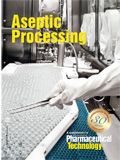
Newsletter
Get the essential updates shaping the future of pharma manufacturing and compliance—subscribe today to Pharmaceutical Technology and never miss a breakthrough.


